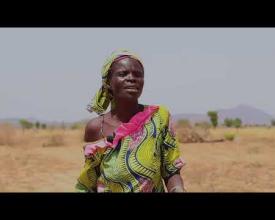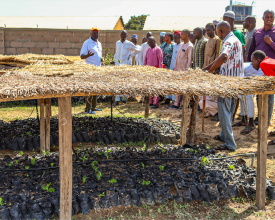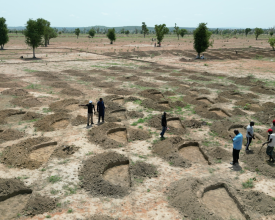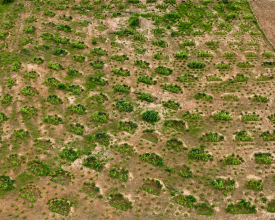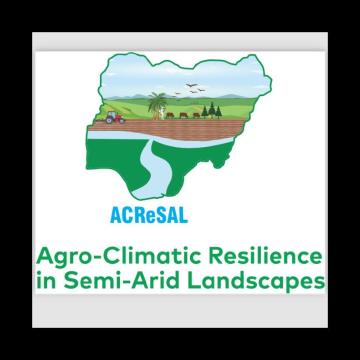
Cultivating Change: Innovative support for small farmers in Adamawa State through Regenerative Agriculture

The Agro-Climatic Resilience in Semi-Arid Landscapes (ACReSAL) project in Adamawa State, Nigeria, aims to combat land degradation and enhance climate resilience by promoting regenerative agriculture practices. Supported by the World Bank, this 6-year project (2022-28) targets landless smallholder farmers by persuading landowners to lease 2,100 hectares of land rent-free for 10 years.
Regenerative agriculture restores soil health through techniques like no-till farming, mulching, cover cropping, and reducing synthetic chemicals, while integrating livestock and bees into the farming system. These practices aim to rejuvenate soil degraded by intensive farming and promote sustainable agricultural productivity.
This initiative addresses challenges of soil degradation and food insecurity by promoting climate-resilient farming. The project not only restores the land but aims to set a precedent for adopting regenerative agriculture across Nigeria.
Context
Challenges addressed
- Climate variability: Unpredictable weather patterns, including more frequent and intense droughts, heat waves, and floods, affect crop and livestock productivity.
- Land degradation: Soil erosion, nutrient depletion, and desertification reduce arable land and productivity.
- Limited access to water: Poor irrigation access hinders year-round farming, particularly during the dry season.
- Limited access to finance: Smallholder farmers struggle to secure finance, limiting investment in better practices, equipment, and inputs.
- Pests and diseases: Monoculture and moisture stress lead to unpredictable pest and disease outbreaks, reducing yields.
- Diminishing tree cover: Trees help sequester carbon, improve soil stability, and enhance biodiversity, boosting crop productivity.
- Limited diversification: Reliance on a narrow range of crops or livestock reduces resilience to climate and market risks.
- Lack of modern techniques: Limited knowledge of efficient irrigation, crop rotation, and pest control keeps yields low.
Location
Process
Summary of the process
Community sensitization and participation are critical to the success of the ACReSAL project, ensuring local understanding and ownership of the state-led intervention focused on restoring degraded landscapes in Northern Nigeria. This engagement strengthens community capacity and fosters sustainable agriculture and landscape management, which is essential for long-term project sustainability. The project also promotes farmer-led irrigation development plans, empowering landless farmers to adopt sustainable practices.
These elements are complemented by livelihood support through public-private partnerships, which bring together the government (ACReSAL), private sector, and farmers to improve agricultural productivity. Institutional strengthening further enhances the project's impact by building the capacity needed to manage resources effectively. This synergy between sustainable agriculture, community involvement, irrigation planning, and cross-sector collaboration ensures positive outcomes in Adamawa State, creating a replicable model for other regions.
Building Blocks
Sustainable Agriculture and Landscapes Management
The integration of sustainable agriculture and landscape management practices in land restoration efforts is crucial in conserving soil and water, promoting biodiversity, and mitigating climate change. This approach also improves livelihoods, enhances ecosystem services, and builds resilience. To achieve this, we conducted thorough assessments, engaged local farmers and other stakeholders, developed context-specific plans, provided training, monitored progress, and foster policy support. This ensures a holistic and sustainable restoration of degraded lands, benefiting both people and the environment, including water resources. It's important for the community to collaborate, contribute, and learn effective environmental management approaches to ensure the project's long-term sustainability and unsustainable agricultural practices.
Enabling factors
- Prioritizing alternative livelihood options in land restoration.
- Sensitizing the community to environmental issues and methods to prevent land degradation.
- Integrating climate smart agriculture in soil restoration.
- Community Ownership and government support.
Lesson learned
- Emphasizing the importance of community participation to identify their top priority issues.
- Raising community awareness of all interventions, including gully restoration and reforestation, through comprehensive awareness campaigns.
- Establishing an interim engagement point, such as collaborating with traditional leaders, to secure community support
Community strengthening
Enhance community's capacity to manage the environment, recognizing that over 80% of environmental issues occur in rural areas. This underscores the importance of upskilling and empowering them to improve environmental management.
Enabling factors
- Ensure community participation and support in all activities.
- Establish Community Interest Groups (CIGs) elected by the communities to be involved throughout the process.
- Engage focal NGOs to educate and sensitize community members on environmental issues.
Lesson learned
Community ownership of the projects and a thorough understanding of the project objectives have been crucial for the success of this community-strengthening process. By fostering a sense of ownership, the community becomes more interested in the outcomes, leading to greater engagement and commitment. Ensuring that community members fully grasp the goals and benefits of the projects and contribute to the decision-making process. This collective involvement not only enhances the effectiveness of the initiatives but also builds local capacity, resilience to climate change, and long-term sustainability.
Livelihood Support through Public Private Partnership
The ACReSal portfolio aims to lift 3.4 million Nigerians out of poverty, recognising that land degradation is a key factor contributing to poverty. A crucial tool in achieving climate smart agricultural initiative while also promoting environmental sustainability. The lease of land by both the private and government sector will enable landless farmers to farm and improve their livelihoods.
Enabling factors
- Government and private sector support
- Farmers participation.
- Training and provision of seedlings.
Lesson learned
Public-private partnerships (PPPs) bring together the expertise of both the public and private sectors, allowing each sector to do what it does best in order to deliver projects and services in the most efficient manner.
Institutional strengthening & sustainability
The ACReSAL project collaborates with three key ministries: Environment, Agriculture, and Water Resources. It operates across multiple institutional levels, including state, national, local, and community levels. This approach ensures that project implementers at all ministerial levels have their capacities strengthened, thereby sustaining the project's investments and efficient landscapes management.
Enabling factors
- Effective collaboration across the three Ministries and the Institutions that are implementing the project through regular stakeholder engagements.
- Technical support from the World Bank, the team provide support across project activities and ensure impactful project implementation.
Lesson learned
The synergy between the Ministries and institutions is key to producing results, because for impactful results for the project it is key that all Ministries must work closely together. The synergy has provided more innovative and collaborative ideas for effective project delivery.
Farmer-led irrigation development plans
The intention is to ensure access and availability of water for farmers and for domestic use and irrigation purposes for pastoralists in the community. Farm-led irrigation will help farmers be able to carry out year round agricultural activity, which will contribute to increased food production as well as improving livelihoods.
Enabling factors
- Capacity building of farmers to support in their ability to develop irrigation plans
- Formation of Community Interest Groups and sensitization
- Provision of solar powered panels, drilling of boreholes and water tanks to better store their water
Lesson learned
- Due to issues relating to competition of declining natural resources between farmers and herders. Farmer led irrigation can enable farmers to stay within their locations and land and reduce herders movement and therefore reduce the likelihood of natural resource based conflicts and can act as a mechanism to improve peacebuilding opportunities between farmers and herders.
- Improved standard of living in relation to community health as there is a improvement in their access to clean water provisions.
Impacts
This innovative initiative removes financial barriers, enabling landless farmers to practice climate-resilient agroforestry and achieve sustainable harvests. As of June 2024, over 20,000 farmers have been trained in regenerative agriculture through training and demonstration centers set up in Yola North, Girei, and Yola South LGAs in Adamawa State. The crops from the demonstration plots—maize, watermelon, vegetables, pigeon pea, and cowpea—were given to the farmers who cultivated them, providing food for home consumption or additional income from sales.
In addition, Adamawa State’s ACReSAL project has secured rent-free, 10-year leases for 375 hectares of land across five LGAs, with 582 farmers now operating on 256 hectares of this land. These plots are leased at a rate of 1 acre (0.4 hectares) per farmer, providing landless farmers the opportunity to cultivate and sustain their livelihoods.
This outcome-based food production system not only restores soil health but also supports sustainable agriculture through strong partnerships between the government, private sector, and local farmers. The success of this approach in Adamawa serves as a model for scaling similar projects across other regions, offering long-term solutions for climate resilience and food security.
Beneficiaries
20,000 male and female farmers are direct beneficiaries of this project
Sustainable Development Goals
Story
Denis Damara from Girei LGA is convinced of the approach: ‘I am a seasoned farmer but I have learnt a lot of new things here. Some of the things I learnt are that we should avoid burning our farms. I have learnt that we should preserve the grasses and stalks after harvesting our crops so that they can serve as mulch to the soil and then to conserve moisture in the soil. Another thing I have learnt is how to prune trees and construct half-moon structures to conserve water for the trees and the food crops around the tree. I have tried this at home and it works.”
